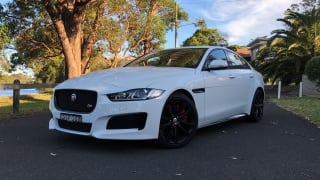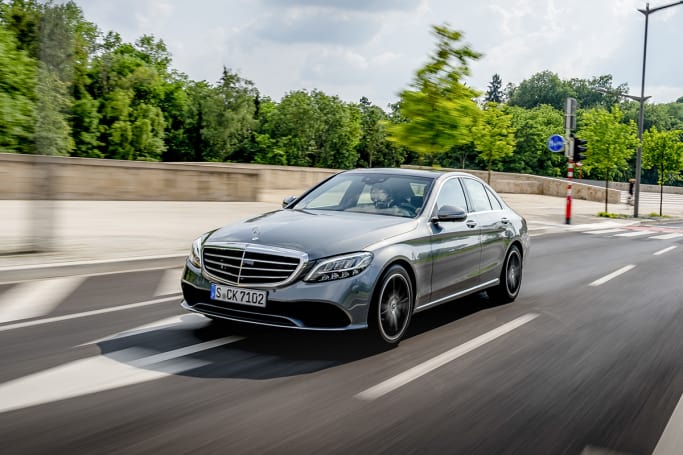
Jaguar XE 2018 review
After a week in a snarling Jaguar XE S - all supercharged V6 and howling exhaust - we have to ask, why are so many Australians climbing out of super sedans and into stodgy SUVs?
Browse over 9,000 car reviews
If you’re picturing the premium mid-size segment in Australia, you’re almost certainly picturing Mercedes-Benz. Honestly, the premium carmaker has the kind of powerful and unquestioning stranglehold on the segment that would have despots and dictators turning green with envy.
The C-Class often outsells its nearest competitor by a factor of two to one. Even more impressive, that nearest competitor is another Mercedes, the CLA. Audi and BMW are left off in the middle distance, duking it out for third and fourth place.
So yes, the C-Class is a very important car for Mercedes. And this new one, updated for 2019, is even more so. It’s the first major update in the current car’s four-year lifespan, with a handful of exterior tweaks, some new key cabin technology and, most importantly, a new and clever engine option for its top-selling version.
So is that enough to keep the C-Class at the top of the mid-size pile?
| Mercedes-Benz C-Class 2018: C220 D Sport Edition | |
|---|---|
| Safety rating | |
| Engine Type | 2.1L turbo |
| Fuel Type | Diesel |
| Fuel Efficiency | 4.7L/100km |
| Seating | 4 seats |
| Price from | $46,420 |
Mercedes is so far keeping mum on the details, ahead of the updated car’s arrival in August, but you can expect to see prices climb a little from their current levels ($61,900 - $100,611, and $120,642 for the C 43 cabriolet).
The C200 will retain 18-inch alloy wheels, artificial leather (and electric in the front) seats, nav, ambient interior lighting and keyless entry and push-button start, but critically adds a new 12.3-inch screen in the driver’s binnacle that replaces the traditional dials. It joins a landscape-oriented 10.25-inch centre screen - both now standard across the C-Class range - which propels the cabin into a clean and modern-feeling future.

The C220d and C300 features list will likely change little, but all get Mercedes’ new 'Touch Control' steering wheel, as well as new LED head and tail-lights, while the C 43 AMG 4Matic gets the best of Merc's autonomous driving technology.
Expect more information to arrive around July. The C 63 AMG is also due for updating, with a new model scheduled to arrive around December.
Perhaps not quite blink and you’ll miss them, but we're not talking radical changes either, folks. Benz tells us as much as 50 per cent of the C-Class components are new or changed, but it has clearly subscribed to the 'if it ain’t broke' philosophy in the design department.

Yes, there are new bumpers front and rear, new LED light configurations and new colours and wheel designs, but we’re not talking huge changes outside. Still, the C-Class cuts a fine figure on the road, what with its intricate alloys, bonnet-defining grille and simple, understated body contours. Australia will take every available body style, too, including sedan, coupe, cabriolet and - our personal favourite - the 'estate' station wagon.
The C 43 AMG now gets the twin-blade grille design used on the V8-powered models, as well as a two pairs of rounded exhaust tips at the rear.

Inside, though, the changes are more substantial. For one, the new-generation Mercedes Touch Control steering wheel arrives as standard, as does a new and very effective 12.3-inch screen that replaces the traditional dials in the instrument cluster (standard on every model).
The cabin remains a peaceful and premium-feeling space, with a fine use of materials (including quilted leather on the door panels, polished silver or faux-wood for the centre console and leather for the steering wheel), and Benz deserves credit for ensuring that sense of luxury extends to backseat riders.
It all depends, really. All C-Class variants sit on the same 2840mm wheelbase, and stretch 1810mm in width. The sedan, coupe and cabriolet versions measure 4686mm in length, while the Estate’s bigger cargo area increases its size to 4702mm.
Predictably, then, the estate offers the most useable (VDA) boot space, with 490 litres with the rear seats in place, swelling to 1510 litres with the rear seats folded flat. The sedan version is next on the cargo-carrying list, with 455 litres, followed by the 380 litres of the coupe and 285 litres of the cabriolet.

We spent our entire time in the four-door sedan models, and we can report a spacious and comfortable space for driver and passenger (you could play ping pong on the wide centre console) with two cupholders and room in each of the front doors for bottles. There’s all the USB and power connections you might need (most housed in a deep storage bin that separates the front seats) and the more expensive models offer wireless charging for compatible phones, too.
Climb into the sedan’s back seat, and you’ll find impressive legroom (behind my own 176cm driving position), but headroom - especially in sunroof-equipped cars - feels a little tighter. The rear seat is actually wide enough to fit three adults at a pinch, but the tall and bulky tunnel absolutely obliterates leg room for the middle-seat rider.
There are two cupholders in the pulldown divider that separates the backseat, as well two ISOFIX attachment points. Rear occupants also get there own air vents, as well as a 12-volt power source.
It’s here where the C-Class is at its most updated, serving up a new turbocharged 1.5-litre hybrid engine in the entry-level C200. Alone, it’s good for 135kW/280Nm, but it’s combined with a clever 48-volt system that adds up to 11kW of bonus power low in the rev range, happily plugging the power void usually left by turbo lag when taking off, or if you plant your foot when overtaking.

The C300 is powered by a more conventional 2.0-litre, four-cylinder good for 190kW/370Nm, while the sole diesel (in the C220d) is a four-cylinder unit that produces 143kW/400Nm. All are paired with a nine-speed automatic transmission.
The C 43 4Matic's engine remains a fabulous thing, only now tweaked for a little bit more power. It's good for 287kW/520Nm, and is paired with a nine-speed transmission that sends the power to all four wheels, albeit with a bias toward the rear tyres.
Let’s start with the C200, where the addition of the clever hybrid system has helped drop fuel use to a claimed 6.0-6.3 litres per hundred kilometres. The old car delivered 6.5 per hundred, but was slightly quicker from 0-100km/h (7.2sec- 7.7sec).
The C300 will sip a claimed 6.5-6.9L/100km on the same cycle, while the diesel requires a miserly 4.7 litres. The C 43 is the thirstiest, of course, needing 9.1-9.3L/100km on the same cycle.
The C200 makes do with a 41-litre tank (as does the diesel) while the C300 steps that up to a 66-litre tank. And all those numbers related to the sedan body shape, so expect some slight variations if you’re shopping for a coupe cabriolet or estate.
Keen to sample the new hybrid tech in the C200, we made a beeline for the cheapest C-Class. And if you’d told me, even a handful of years ago, that a piddly 1.5-litre engine would be enough to drag the 1555kg Benz around, I’d have labelled you crazier than Donald Trump's Twitter account.
The C200’s system is a unique hybrid set-up, in the sense that it only delivers extra power in the tiniest of circumstances, but they’re the areas that it really needs it. From a standstill, the electric motor delivers its extra 11kW of oomph at just the right moment need to help get you moving (the same when overtaking) and it does genuinely make a difference.
It can’t completely overrule the concrete laws of physics, though. Plant your foot on anything that even looks like a hill and you can definitely hear that 1.5-litre engine working hard - interrupting the ambience of the cabin - but keep it in the sweet-spot of the rev range and it’s a quiet, capable-feeling engine that delivers more punch than its size might suggest.
On Germany’s epic autobahns, the needle even sailed past 215km/h without too much encouragement (even if I could have knitted a sweater in time it took to to close the last 10-or-so-kilometres). Is that relevant for Australia? Sadly not, but it does suggest the engine is more capable than we will ever need it to be.

Elsewhere, the not-too-different C-Class rides an absolute dream, smooth-sailing over bumps and road imperfections, and the cabin is serene and comfortable - though there was more wind noise at times than I was expecting.
Downsides? Well, the cheapest C-Class doesn’t feel the most dynamic offering, with the light steering serving up a slight disconnect between the steering wheel and the road below in its most comfortable settings. Switching to Sport improves matters, but if you’re life is mostly city and suburbs, it will matter little.
The nine-speed transmission can behave oddly at times, too; smooth and lightning fast as it climbs the gears, and mostly perfect on the way back down. But I noticed a definite thump occasionally as it shifted down from second to first gear, which stripped a little refinement from the drive experience.
It's more noticeable in the C 43 4Matic AMG, but it's vastly overshadowed by the thick and meaty power delivery from that stonking turbocharged engine. It's a rocket, and while it's not as fast or as loud as its C 63 big brother, I honestly think the tweaked C 43 is all the AMG I'd ever need.
Basic Warranty
3 years / unlimited km warranty
ANCAP Safety Rating

Detailed specifications for Australia are still being finalised for the C-Class, but we don’t think the standard safety equipment will change much.
So expect a comprehensive suite of airbags (including front, front-side, head for the first and second rows and a driver knee bag), joined by the usual kit of traction and braking aids on the C200. Blind-spot assist, tyre-pressure monitoring and AEB - part of the Collision Prevention Assist Plus package - also arrive as standard.
Higher trim levels will nab active cruise, with stop and go, rear cross-traffic alert, active blind-spot monitoring system and active lane keep assist, while the C 43 scores Mercedes' most advanced auto-driving tech.
While specific maintenance pricing is yet to be confirmed, each of these models is covered by three-year warranty, with service intervals pegged at 25,000km or 12 months.
Baby steps these might be, but they're important ones for Benz. The new in-cabin tech and clever engine in the cheapest models only strengthen the C-Class proposition, without taking anything away from the drive experience, cabin ambiance and utterly sublime ride.
In short, Mercedes' reign at the top of the premium mid-size segment is unlikely to be toppled anytime soon.
| Vehicle | Specs | Price* | |
|---|---|---|---|
| C63 S | 4.0L, PULP, 7 SP AUTO | $103,510 – 119,020 | 2018 Mercedes-Benz C-Class 2018 C63 S Pricing and Specs |
| C63 S | 4.0L, PULP, 7 SP AUTO | $93,500 – 107,470 | 2018 Mercedes-Benz C-Class 2018 C63 S Pricing and Specs |
| C200 Sport Edition | 2.0L, Hyb/PULP, 9 SP AUTO | $47,080 – 54,780 | 2018 Mercedes-Benz C-Class 2018 C200 Sport Edition Pricing and Specs |
| C220 D Sport Edition | 2.1L, Diesel, 9 SP AUTO | $46,420 – 54,010 | 2018 Mercedes-Benz C-Class 2018 C220 D Sport Edition Pricing and Specs |
| Price and features | 8 |
|---|---|
| Design | 8 |
| Practicality | 7 |
| Under the bonnet | 8 |
| Efficiency | 8 |
| Driving | 9 |
| Safety | 7 |
| Ownership | 7 |
$28,490
Lowest price, based on 103 car listings in the last 6 months